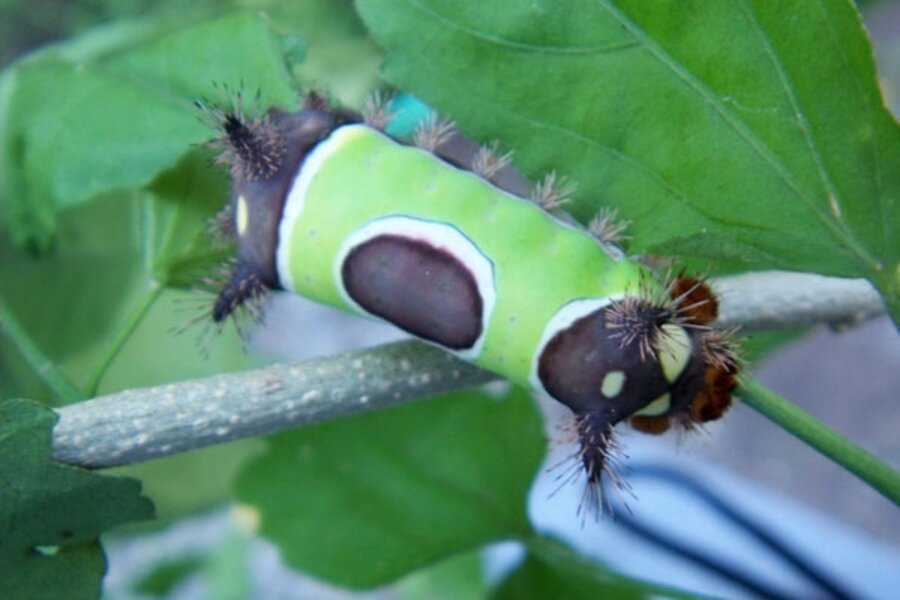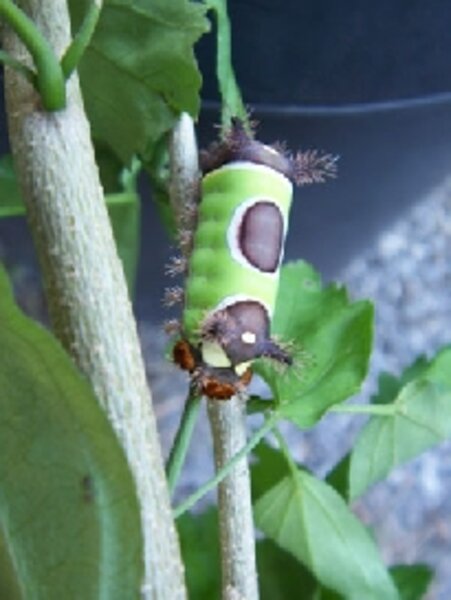Meet my favorite caterpillar
Loading...
Sometime in early fall you might feel that it’s time to cut back some of your perennials before winter. And when you do, you may come upon this little guy in the photo above and at right. I wanted to show you how beautiful it is.
This is the saddleback caterpillar.
It is a late summer visitor and can get your attention very quickly. I most often find it on an upright stem of aster, lily, dahlia, goldenrod, or other lanky late foliage – and as I grab the bunch of stems to cut back the spent foliage, I get a palm full of stinging spines.
This is a defense mechanism to keep them from being eaten by birds.
In reading about this critter, I’ve learned it is one of the slug caterpillars – the family is Limacodidae. The saddleback, Acharia (formerly Sibine) stimulea, is common to the eastern US, and the Atlantic states in particular.
While all the members of this family are all unusual looking and have stinging hairs, the saddleback is my favorite because I love chartreuse in the garden, and this one has a chartreuse saddle.
There are never very many saddlebacks around. It’s not like the fall webworm or rose slugs or other abundant creatures. They won’t march on your garden.
In the transition between the insecure early days of my gardening career and becoming a confident home gardener, I was arrogant (and stupid) about not wearing gloves. My excuses: I wanted to feel the leaves and the soil, nature is textural, blah, blah.
Well, you know what happens when arrogance takes over … now I wear gloves, especially in the late summer.
Although I occasionally get stung, I never kill this caterpillar. I hope you will marvel as I have at the beauty and armament of this fellow companion of the late-season garden. Look for it along the vertical stems, hiding under the top growth of your plants.
In other caterpillar news, I was surprised this year by the absence of the tiny wasps that use the tobacco hornworm (which feeds on my tomato plants) as an incubator/cafeteria. Usually, it’s hard for me to find the hornworms without the parasitic wasp pupal cocoons that look like rice grains.
Perhaps the long, cool, rainy spring was a factor in their absence. In any case, the hornworms ate well and have now disappeared to grow wings, learn to fly, and lay more eggs.
Just when you come to expect nature to behave in a predictable way, you get a new opportunity to wonder.
Donna Williamson is a master gardener, garden designer, and garden coach. She has taught gardening and design classes at the State Arboretum of Virginia, Oatlands in Leesburg, and Shenandoah University. She's also the founder and editor of Grandiflora Mid-Atlantic Gardening magazine, and the author of "The Virginia Gardener's Companion: An Insider's Guide to Low Maintenance Gardening in Virginia." She lives in the Shenandoah Valley of Virginia.
Editor’s note: To read more by Donna, check Our blog archive. For more Monitor gardening, see our main gardening page and our RSS feed.
You may also want to visit Gardening With the Monitor on Flickr. Take part in the discussions and get answers to your gardening questions. If you join the group (it’s free), you can upload your garden photos and enter our next contest. We'll be looking for photographs of fruits. So find your best shots of summer's blueberries, peaches, plums, etc., and get out your camera to take some stunning shots of early fall apples. Post them before Sept. 30, 2009, and you could be the next winner.






